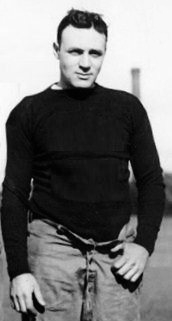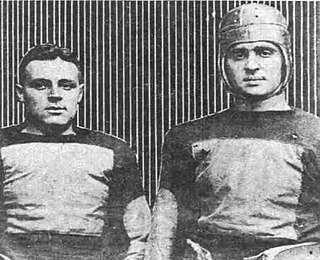
Leather is a strong, flexible and durable material obtained from the tanning, or chemical treatment, of animal skins and hides to prevent decay. The most common leathers come from cattle, sheep, goats, equine animals, buffalo, pigs and hogs, and aquatic animals such as seals and alligators.
A football is a ball inflated with air that is used to play one of the various sports known as football. In these games, with some exceptions, goals or points are scored only when the ball enters one of two designated goal-scoring areas; football games involve the two teams each trying to move the ball in opposite directions along the field of play.

The Rawlings Gold Glove Award, usually referred to as simply the Gold Glove or Golden Glove, is the award given annually to the Major League Baseball (MLB) players judged to have exhibited superior individual fielding performances at each fielding position in both the National League (NL) and the American League (AL). The Gold Glove is widely considered one of the most prestigious defensive awards in baseball.
A hide or skin is an animal skin treated for human use. The word "hide" is related to the German word Haut, which means skin. The industry defines hides as "skins" of large animals e.g. cow, buffalo; while skins refer to "skins" of smaller animals: goat, sheep, deer, pig, fish, alligator, snake, etc. Common commercial hides include leather from cattle and other livestock animals, buckskin, alligator skin and snake skin. All are used for shoes, clothes, leather bags, belts, or other fashion accessories. Leather is also used in cars, upholstery, interior decorating, horse tack and harnesses. Skins are sometimes still gathered from hunting and processed at a domestic or artisanal level but most leather making is now industrialized and large-scale. Various tannins are used for this purpose. Hides are also used as processed chews for dogs or other pets.

Shell cordovan,cordovan, or cordwain is a type of tanned fibrous connective tissue commonly used in high-end shoemaking. Cordovan is an equine leather made from the fibrous flat connective tissue beneath the hide on the rump of the horse. The leather derives its name from the city of Cordoba, Spain, where it was first produced by the Visigoths in the seventh century, and later also by the Moors. It is a difficult and expensive leather to make, and in the late 19th and early 20th century was mostly used for razor strops to hone razors in barber shops. More recently it has been increasingly used for shoes, wallets, and watch straps due to its aesthetic qualities and exceptional durability. It is also used in archery to protect the fingers. It is smooth and durable, ideal for a finger tab. Shell cordovan has a unique non-creasing characteristic. Because it is made of connective tissue, it is smooth and lacks the pebbled effect of leather derived from animal skin.

The Wilson Sporting Goods Company is an American sports equipment manufacturer based in Chicago, Illinois. Wilson makes equipment for many sports, among them baseball, badminton, American football, basketball, fastpitch softball, golf, racquetball, soccer, squash, tennis, pickleball and volleyball.

Division Street is a major east-west street in Chicago, Illinois, located at 1200 North. Division Street begins in the Gold Coast neighborhood near Lake Shore Drive, passes through Polonia Triangle at Milwaukee Avenue into Wicker Park and continues to Chicago's city limits and into the city's western suburbs. Once known as "Polish Broadway" during the heyday of Polish Downtown, Division Street was the favorite street of author Nelson Algren. A fountain dedicated in his name was installed in what had been the area that figured as the inspiration for much of his work.

Rawlings Sporting Goods is an American sports equipment manufacturing company based in Maryland Heights, Missouri. Founded in 1887, Rawlings currently specializes in baseball and softball clothing and equipment, producing gloves, bats, balls, protective gear, batting helmets, uniforms, bags. Footwear includes sneakers, and sandals. The company also sells other accessories such as belts, wallets, and sunglasses. Former products manufactured by Rawlings included American football, basketball, soccer, and volleyball balls.

Spalding is an American sports equipment manufacturing company. It was founded by Albert Spalding in Chicago in 1876 as a baseball manufacturer, and is today headquartered in Bowling Green, Kentucky. It sells softballs through its subsidiary Dudley Sports. In the past, Spalding has manufactured balls for other sports, including American football, soccer, volleyball, tennis, and golf.
Nokona Athletic Goods Company is an American manufacturing company of sports equipment and clothing products, specialized in baseball gloves. The company, headquartered in Nocona, Texas, is the last major baseball glove manufacturer in the United States.

Ralph Horween was an American football player and coach. He played fullback and halfback and was a punter and drop-kicker for the unbeaten Harvard Crimson football teams of 1919 and 1920, which won the 1920 Rose Bowl. He was voted an All-American.
Johnston & Murphy is an American footwear and clothing company based in Nashville, Tennessee. Johnston & Murphy designs, sources, markets and distributes footwear, apparel, leather goods and luggage. A subsidiary of Genesco Inc., the Johnston & Murphy Group operates retail and wholesale businesses.

Arnold Horween was an American college and professional American football player and coach. He played and coached both for Harvard University and in the National Football League (NFL).

The Bona Allen Company is a tannery and leather goods factory that opened in 1873 in Buford, Georgia. It became the nation's largest producer of hand-tooled saddles, bridles, horse collars, postal bags, cowboy boots, and shoes and had a contract to supply the sporting equipment giant, Spalding, with raw material for the manufacture of baseballs and baseball mitts. Starting in the early 20th century Bona Allen saddles were offered in the Sears Mail Order catalog under a variety of names. The Bona Allen Company was owned by Bonaparte Allen Sr. Also known as the Bona Allen Shoe and Horse Collar Factory, the factory closed in 1981 after a fire, and the main tannery building was added to the National Register of Historic Places on January 3, 2005. It is located at 554 West Main Street. After another fire on February 10, 2015, firefighters allowed the building to burn itself down.

Hanover Shoe in Hanover, Pennsylvania, was once one of the largest and most successful shoe companies in York County, Pennsylvania.

The Alden Shoe Company is an American shoe company founded in 1884 by Charles H. Alden in Middleborough, Massachusetts. Alden specializes in handcrafted men's leather boots and dress shoes, such as Oxfords, Blüchers, loafers, and Chukka boots.

Elston Avenue is a street in the city of Chicago, serving as an alternate route along the east side of the Kennedy Expressway. It begins at Milwaukee Avenue, just north of Chicago Avenue. It travels northwest for almost 10 miles (16 km) until ending at Milwaukee Avenue again, just south of Devon Avenue. The road never strays too far from either the Kennedy Expressway or Milwaukee Avenue.

In Canada and the United States, a football is a ball, roughly in the form of a prolate spheroid, used in the context of playing gridiron football. Footballs are often made of cowhide leather, as such a material is required in professional and collegiate football. Footballs used in recreation, and in organized youth leagues, may be made of rubber, plastic or composite leather.
The leather industry is a major industry in Bangladesh and the Government of Bangladesh has declared it as a priority sector. The industry was the second largest export sector of Bangladesh in FY 2014–2015. The industry also plays a role in creating employment. However, Human Right Watch reported that it is responsible for pollution of air, water, and soil, that lead to serious health problems in the population. It is also known to be largely involved in child labour.


















